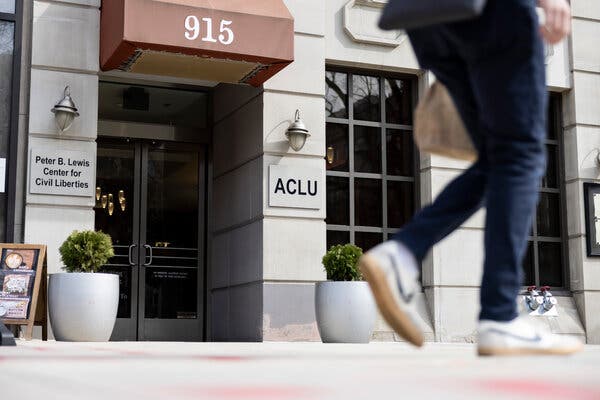Stocks on Wall Street are set to rise about 1 percent when markets open on Monday, following a jump in Asian and European stocks after a rout in government bonds subsided.
The S&P 500 index fell nearly 2.5 percent last week but was set to recover nearly half of these losses on Monday. The Stoxx Europe 600 index climbed 1.3 percent, with gains in every sector, and Asian stock indexes closed broadly higher. Over the weekend, U.S. federal regulators authorized the one-shot Johnson & Johnson Covid-19 vaccine, adding to the positive market sentiment.
The Senate this week will begin work on a $1.9 trillion relief package passed by the House on Saturday. Democrats in the Senate, which is evenly split, face political and procedural challenges. Lawmakers are aiming to send the bill to President Biden for enactment by March 14, when unemployment benefits will begin to expire for some jobless workers.
The 10-year yield on U.S. Treasury notes was at 1.43 percent, down from as high as 1.61 percent on Thursday. Globally, long-dated bond yields fell from Australia to Britain on Monday. Last week, rising yields and higher inflation expectations led some traders to question when central banks would have to pull back on their easy-money policies. And the Bank of England’s chief economist said central bankers needed to avoid being complacent about how difficult it might be to tame inflation.
The prospect of tighter monetary policy knocked stock indexes down from their recent highs, and the Nasdaq fell nearly 5 percent last week as technology stocks lost value.
On Monday, Nasdaq futures rose about 1.5 percent. “We do not expect the tech sell-off to extend much further and continue to see value in the sector for longer-term investors,” strategists at UBS wrote in a note.
Elsewhere in markets
-
Commodity prices also rose, including oil. Futures of West Texas Intermediate, the U.S. crude benchmark, rose 1.5 percent to $62.41 a barrel.
-
Homebuilders such as Persimmon, Barratt Developments and Taylor Wimpey were the biggest gainers in the FTSE 100 index ahead of the British government’s budget presentation on Wednesday, when the chancellor is expected to announce a new mortgage guarantee program to help people buy houses with small deposits.
-
The Bank of Ireland said it was closing a third of its branches, 103 in total, in the Republic of Ireland and Northern Ireland. The bank’s shares rose 3.5 percent as it announced the cost-cutting measure after reporting steep losses for its past fiscal year.

Heidelberg, Germany, is at the forefront of a movement: the push to get rid of cars entirely.
Heidelberg, a city of 160,000 people on the Neckar River, is one of only six cities in Europe considered “innovators” by C40 Cities, an organization that promotes climate-friendly urban policies and whose chairman is Michael Bloomberg, the former mayor of New York. (The others are Oslo, Copenhagen, Venice, and Amsterdam and Rotterdam in the Netherlands.)
Eckart Würzner, Heidelberg’s mayor, is on a mission to make his city emission free, Jack Ewing reports for The New York Times. And he’s not a fan of electric vehicles — he wants to reduce dependence on cars, no matter where they get their juice.
Heidelberg is buying a fleet of hydrogen-powered buses and designing neighborhoods to discourage all vehicles and encourage walking. It is building a network of bicycle “superhighways” to the suburbs and bridges that would allow cyclists to bypass congested areas or cross the Neckar without having to compete for road space with motor vehicles. Residents who give up their cars get to ride public transportation free for a year.
“If you need a car, use car sharing,” Mr. Würzner said in an interview.
Battery-powered vehicles don’t pollute the air, but they take up just as much space as gasoline models. Eckart Würzner, Heidelberg’s mayor, complains that Heidelberg still suffers rush-hour traffic jams, even though only about 20 percent of residents get around by car.
“Commuters are the main problem we haven’t solved yet,” Mr. Würzner said. Traffic was heavy on a recent weekday, pandemic notwithstanding.

A police reform bill in Massachusetts has managed to strike a balance on regulating facial recognition, allowing law enforcement to harness the benefits of the tool while building in protections that might prevent the false arrests that have happened before, Kashmir Hill reports for The New York Times.
The bill, which goes into effect in July, creates new guardrails: Police first must get a judge’s permission before running a face recognition search, and then have someone from the state police, the F.B.I. or the Registry of Motor Vehicles perform the search. A local officer can’t just download a facial recognition app and do a search.
The law also creates a commission to study facial recognition policies and make recommendations, such as whether a criminal defendant should be told that they were identified using the technology.
Lawmakers, civil liberties advocates and police chiefs have debated whether and how to use the technology because of concerns about both privacy and accuracy. But figuring out how to regulate it is tricky. So far, that has generally meant an all-or-nothing approach.
City councils in Oakland, Calif., Portland, Ore., San Francisco, Minneapolis and elsewhere have banned police use of the technology, largely because of bias in how it works. Studies in recent years by MIT researchers and the federal government found that many facial recognition algorithms are most accurate for white men, but less so for everyone else.






